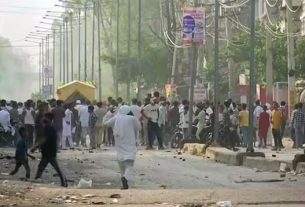So often one item comes to symbolise an entire protest movement. In China, that item is a humble piece of blank paper.
As dusk fell on Shanghai on Sunday evening, some of those who gathered at a vigil to remember the victims of a fire that catalysed the demonstrations came clutching sheets of paper.
Similarly, in the capital Beijing, protesters came armed with scraps of paper to a demonstration at Beijing’s prestigious Tsinghua University, once attended by President Xi Jinping.
And in another striking video a young woman could be seen walking through the streets of Wuzhen – a town in the eastern province of Zhejiang – with chains around her wrists and duct tape over her mouth. In her hands was a sheet of unspoiled blank paper.
The trend has its roots in the 2020 Hong Kong demonstrations, where locals held blank pieces of paper to protest against the city’s draconian new national security laws.
Activists held the paper aloft after authorities banned slogans and phrases associated with the mass protest movement of 2019 that saw the city grind to a halt and officials violently clamp down on demonstrators.
Some have argued that the gesture is not only a statement about the silencing of dissent, but also a challenge to authorities, as if to say ‘are you going to arrest me for holding a sign saying nothing?'”
“There was definitely nothing on the paper, but we know what’s on there,” a woman who joined protests in Shanghai told the BBC.
Johnny, a 26-year old demonstrator in Beijing, told the Reuters news agency that the paper had come to “represent everything we want to say but cannot say”.
Kerry Allen, the BBC’s China media analyst, observed that Chinese censorship officials have gone into overdrive on the country’s social media platforms.
“Tens of millions of posts have been filtered from search results,” she said. “‘Blank sheet of paper’ and ‘white paper’ now also only show sparing results.”
The censors scrubbing of social media has provoked anger online, with one user writing that “if you fear a blank sheet of paper, you are weak inside”.
Meanwhile, paper maker Shanghai M&G Stationary was forced to deny rumours that it had taken all A4 paper off shelves for national security reasons. M&G officials said production and operation was all normal and that they had notified police of a forged document circulating online which had kick-started the rumour.
But the blank sign has also become a lighting rod for abuse from those still loyal to the central government and angered by the waves of protest.
One video, thought to be filmed on Saturday at the Communication University of China in the eastern city of Nanjing, showed an unidentified man angrily snatching a blank piece of paper from a protester before storming away.
In another video from later that night, dozens more students were seen on the campus holding pieces of white paper, standing in silence.
Demonstrators – hamstrung by Beijing’s censorship machine – have also turned to other forms of anti-government comment, including sarcastic expressions of support for China’s harsh Covid policies.
In one case, after officials ordered dozens of white sheet-sporting protesters to stop signing anti-lockdown slogans they responded with sarcastic chants of “more lockdowns” and “I want to do a Covid test”.
And at Tsinghua University some students were seen holding pieces of paper with Friedmann equations scrawled on them, in which the Russian physicist and mathematician explains how the universe evolves over time.
The use of the equation is understood to be a play on the words “Free man”.
But it is paper that has been the most common sight at Chinese demonstrations, joining such items as umbrellas (Hong Kong), rubber ducks (Thailand) and flowers (Belarus) as an emblem of modern protest.__BBC.com





